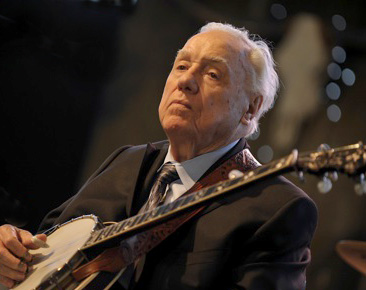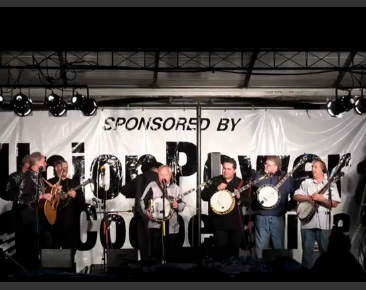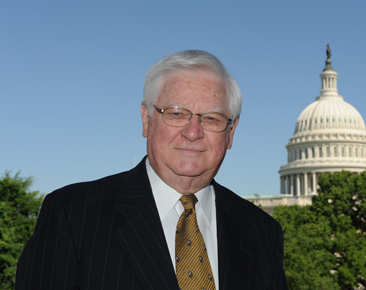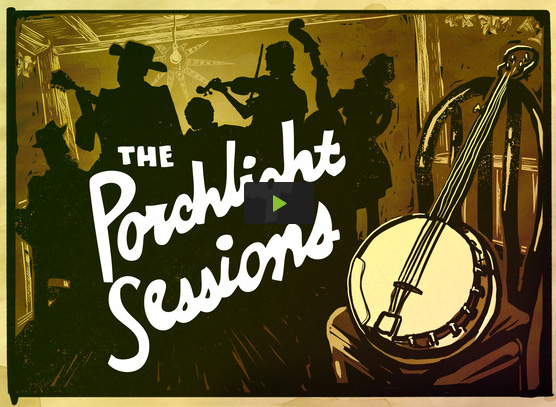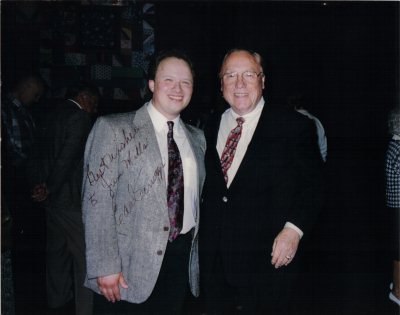
 This tribute to Earl Scruggs on the anniversary of his passing is a contribution from Jim Mills, a life-long student of Scruggs-style banjo, and a serious collector of the sort of pre war Gibson banjos that Earl played. Jim also maintains a large collection of photos and memorabilia of Flatt & Scruggs and other early bluegrass pioneers. After many years touring with the likes of Doyle Lawson and Ricky Skaggs, he now makes his living buying and selling pre war banjos.
This tribute to Earl Scruggs on the anniversary of his passing is a contribution from Jim Mills, a life-long student of Scruggs-style banjo, and a serious collector of the sort of pre war Gibson banjos that Earl played. Jim also maintains a large collection of photos and memorabilia of Flatt & Scruggs and other early bluegrass pioneers. After many years touring with the likes of Doyle Lawson and Ricky Skaggs, he now makes his living buying and selling pre war banjos.
 Something really astonishing has occurred to me that I never thought possible, something I can honestly say never even crossed my mind when I was younger.
Something really astonishing has occurred to me that I never thought possible, something I can honestly say never even crossed my mind when I was younger.
I have lived an entire year – 12 months, 52 weeks, 365 days as of today, Thursday March, 28 2013 – on this planet without my musical hero, Mr. Earl Scruggs, being here in person.
This never crossed my mind because I guess in my earlier years, Earl was simply bigger than life to me. He was there on the Beverly Hillbillies show every week, kicking it off and ending the program with the theme song. He was there on all those Flatt and Scruggs album covers and songbooks that I studied, and still have to this day. He and his music had absolutely infiltrated my heart, brain, and mind so thoroughly that he’d become an integral part of me.
He was the one and only catalyst for my life’s passion, Playing The Banjo, like tens of thousands of others out there today. Had I not heard Earl play, I’d have more than likely not learned to play the banjo.
It’s a rare thing for a person in this day and age to actually get to meet and know their Hero in life. And by the term hero, I mean a real hero. Not just someone you look up to, admire, etc., but a major inspiration and driving force throughout your life.
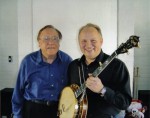 Think about it for a minute… what would it mean to a top classical violinist if he or she could drive over to Paganini’s house, or to a rock guitar player if they could go to Jimi Hendrix’s place? Have him come to the door and greet them warmly, then go inside and sit down and talk for a while, and maybe even play some music together. Well, I got to do just that with my Hero, Mr. Earl Eugene Scruggs, and even though I didn’t go to see him that often – or call him that often, either – I still had solace in knowing that Earl was there at home on Franklin Road, and I could pick up the phone and call say “Howdy Earl,” and hear his voice on the other end of the line whenever I wanted to.
Think about it for a minute… what would it mean to a top classical violinist if he or she could drive over to Paganini’s house, or to a rock guitar player if they could go to Jimi Hendrix’s place? Have him come to the door and greet them warmly, then go inside and sit down and talk for a while, and maybe even play some music together. Well, I got to do just that with my Hero, Mr. Earl Eugene Scruggs, and even though I didn’t go to see him that often – or call him that often, either – I still had solace in knowing that Earl was there at home on Franklin Road, and I could pick up the phone and call say “Howdy Earl,” and hear his voice on the other end of the line whenever I wanted to.
When that came to an end last March 28th it left a great void in my world, and as I said, I guess it was one of those things you never want to think about, and so I just didn’t. But now as time has flown by this past year, as it continues to do, I can look back and be so very thankful that I did get to know my Hero in life. And not only my Hero, but many other people’s Hero too.
I thought for a moment and pondered… I’m one of the most fortunate folks I know to have gotten to know the Absolute Architects of what we know today as Bluegrass Music. I look back now with great joy in knowing that I actually met folks like Bill Monroe, Earl Scruggs, Doc Watson, Chubby Wise, Kenny Baker, Jimmy Martin, Benny Simms, Josh Graves, Benny Martin, Paul Mullins, Jim McReynolds, Doug Dillard, John Hartford and they actually knew my name. This all got me to thinking that we should be grateful for all these folks, maybe even more so than we are.
Kids coming along today in bluegrass will never get to know these musical icons. Can you imagine how many classical artists today would have liked to have met their music’s architects, from Bach to Beethoven and beyond? Or for that matter how many country music stars of today would have liked to have met Hank Williams Sr. or Patsy Cline?
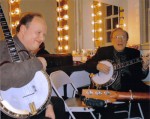 This inspires me to invite you to go out and see your Hero’s of today, and tell them how much you appreciate them. We still have many of the Original Architects here with us: Ralph Stanley, Mac Wiseman, Jim Shumate, Sonny and Bobby Osborne, J. D. Crowe, Paul Williams, Bobby Hicks, Curly Seckler, Jesse McReynolds, just to name a few.
This inspires me to invite you to go out and see your Hero’s of today, and tell them how much you appreciate them. We still have many of the Original Architects here with us: Ralph Stanley, Mac Wiseman, Jim Shumate, Sonny and Bobby Osborne, J. D. Crowe, Paul Williams, Bobby Hicks, Curly Seckler, Jesse McReynolds, just to name a few.
And don’t ignore the modern Hero’s on the scene today. Walk up to Shawn Lane, Michael Cleveland, Ron Stewart, Adam Steffey, Joe Mullins, Ricky Wasson, Barry Bales, Rob McCoury, Dwight McCall, John Bowman, Junior Sisk, Ronnie McCoury, Alison Krauss, Russell Moore, Stuart Duncan, Dan Tyminski, or Tim Stafford and tell them how great a singer or picker they are. They don’t come along but once in a lifetime folks. Tell Doyle Lawson, Ricky Skaggs, Jerry Douglas, J. D. Crowe, Del McCoury, Tony Rice, and Bobby Hicks how good it is to see them and that you’re glad they came. I can tell you they’ll still appreciate it just as much today as they did in their early days – maybe even more – and you’ll never forget meeting them.
Reflecting on this past year, I am reminded of a conversation I overheard at Earl Scruggs’ Memorial Service last March. This conversation was being led by a prominent rock and roll guitarist, and he wasn’t in any way a bluegrass player or historian, but had a world of reverence for Earl’s talent. He said something that day that was so utterly profound, in my opinion, that I’ve never forgotten it.
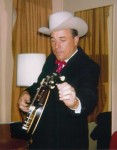 The conversation was concerning Earl Scruggs’ worldwide influence on the masses. He said that “Earl Scruggs just may be the most imitated musician of all time on his respective instrument.” He went on to explain that if you were comparing classical violinists for example, they had their heros and imitators through the decades – Heifetz, then Perlman, and today’s violin hero may be Joshua Bell – but that they all had their heydays so to speak, their moment in the sun. Then another Top Dog’s style or technique would take over the majority of popularity for a decade or so. He then explained that in rock and roll guitar, there was Chuck Berry in the 1950s, then a decade later there was Jimi Hendrix in the ’60s, then Eric Clapton, then Eddie Van Halen, and so on.
The conversation was concerning Earl Scruggs’ worldwide influence on the masses. He said that “Earl Scruggs just may be the most imitated musician of all time on his respective instrument.” He went on to explain that if you were comparing classical violinists for example, they had their heros and imitators through the decades – Heifetz, then Perlman, and today’s violin hero may be Joshua Bell – but that they all had their heydays so to speak, their moment in the sun. Then another Top Dog’s style or technique would take over the majority of popularity for a decade or so. He then explained that in rock and roll guitar, there was Chuck Berry in the 1950s, then a decade later there was Jimi Hendrix in the ’60s, then Eric Clapton, then Eddie Van Halen, and so on.
He then changed gears completely and said, “but Earl Scruggs has held the undeniable title of the greatest single influence the five string banjo has ever known,” and has maintained that title “nonstop for over 60 years now – to this very day.” He said that you could go on You Tube, and there you’d find 9 year old kids trying to copy Earl Scruggs’ playing as closely as possible, note for note, “right this minute.”
And I guess it took this rock and roll guy, far removed from our traditional bluegrass eyes and ears to see this so clearly. I’d never really thought about it in that way before, but I can honestly say that every banjo player I’ve ever met, and had any kind of conversation with about major influences – from J. D. Crowe to Bela Fleck – all admitted that whatever they accomplish with the banjo is mainly due to the inspiration of just one man, Mr. Earl Scruggs.
And to that I say, “Long Live Earl!”

